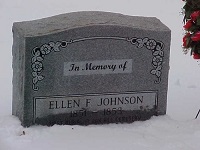Contact Us
Oak Hill Cemetery
1400 E Virginia St
Evansville, IN 47711
Get Directions | Location Details
- Phone: (812) 435-6045
- Staff Directory
- Hours: OFFICE: Mon-Fri 7:30 a.m. to 4:30 p.m. & Sat 9:00 a.m. to 1:00 p.m.
GROUNDS: Sunrise to Sunset
In This Department
Topics of Interest
Department HomeOak Hill Cemetery's First Interment
 On February 18, 1853, Eleanor "Ellen" Johnson, just 17 months old, was the first person buried in Oak Hill Cemetery.
On February 18, 1853, Eleanor "Ellen" Johnson, just 17 months old, was the first person buried in Oak Hill Cemetery.
The burial of Miss Johnson took place in the old part of the burial ground, across from the present (1899) Administration Building.
Her marker--if she had one—has disappeared. Majestic Memorials donated a memorial marker that was placed on Eleanor "Ellen" F. Johnson's grave February 28, 2003.
Presentation on Eleanor "Ellen" Johnson, Oak Hill Cemetery's First Interment
Delivered February 18, 2003, by William E. Bartelt
On February 18, 1853, the citizens of Evansville read the following on page 2 of the Evansville Daily Journal:
Died On Thursday the 17th inst., Eleanor F., daughter of Fielding and Mary M. Johnson age 1 year and 11 months.
The funeral will take place from the residence of her parents at half-past one o'clock to day. The friends of the family are requested to attend without further notice.
These few words provide us with most of what we know about the little girl buried only 10 days after the name Oak Hill was officially selected by the city council. We know nothing about the girl's appearance, personality, or even the cause of her death. Even her name gives us a bit of a mystery.
The newspaper calls her Eleanor, while Oak Hill sexton John Goodge wrote in his original Oak Hill register -- Ellen Johnson -- 2 years old. After examining the family history, I think they are both correct. She was no doubt named for her aunt Eleanor Johnson Foster who died in 1849. There is documentation that this Eleanor was known as Ellen by her family.
While Ellen remains an enigma, research reveals a great deal of information about her family. Her father, Fielding Johnson, was born in the summer of 1810 to John and Nancy Johnson near Vincennes. Fielding's father was active in early Indiana politics and his parents built the first frame house in Pike County, Indiana. They were wealthy enough to provide their children with a library in the home and clothing ordered from the finest stores in the east.
Fielding was Sheriff of Pike County at age 23, a ranger in the Black Hawk War, and later a merchant in Petersburg. His business activities included interests in New Orleans and also in Bowling Green, Kentucky. In 1850 Mr. Johnson entered into a dry goods partnership with William French in Evansville.
One local history tells us that when the Oak Hill lots were offered for sale the top of the hill was rapidly sold to the "best citizens" -- those who had resided in the city for a long time. Fielding Johnson was not in this group; however, he did purchase lot 2 in section 14 just east of the top of the hill. He paid $10.00 for the lot, which easily would have accommodated a dozen burials.
Death was no stranger to Fielding. By the time he was 38 years old he had buried two wives and two young sons. Their graves are marked by simple but graceful stones in an overgrown family cemetery in a field behind that historic frame house west of Petersburg. His second wife, Sarah, died as a result of injuries received in a steamboat explosion near Smithland, Kentucky as she and her children were fleeing a yellow fever epidemic in New Orleans.
Fielding married Ellen's mother, Mary Veale, thirteen years his junior, in December 1849. Mary's family also has a distinguished record in early Indiana and Daviess County history. Fielding assumed an active role in the affairs of Evansville and was elected to the Evansville City Council in 1856. His attendance at the council meetings was less than impressive as he appears to have become obsessed with the issue of slavery--especially in bleeding Kansas. Within a year after his election he moved his family to the Kansas Territory to work against the efforts of those trying to make it a slave state. In Kansas he again established a merchant enterprise, became active in Republican politics, and was appointed by Abraham Lincoln in 1861 to be the United States agent to the Delaware Indians. During the Civil War he raised a Delaware Indian cavalry company and was in command of the Kansas Colored militia. At his death on June 23, 1872 he was praised for his industry, integrity, and patriotism. Mary lived until October 3, 1911.
But one hundred and fifty years ago today politics and business were put aside as the family mourned little Ellen. It had to be late in the afternoon by the time the hearse carrying the little girl's body completed its journey from the home on Locust Street to the new cemetery, a distance of approximately a mile and a half. At the grave on this hillside her mother, father, two half sisters and half brother gathered to say farewell to their loved one--a scene that has occurred thousands of times since that February day, and which will continue to occur from this February day.
As we visit this cemetery today, perhaps we should remember the words Sexton Goodge wrote on the first page of his cemetery register book--maybe a century and a half ago this very day. He wrote "Tread lightly ore this dear and sacred spot where sleeps in peace the ashes of the just...."

Memorial Marker placed on Eleanor "Ellen" F. Johnson's grave February 28, 2003.
Donated by Majestic Memorials.





